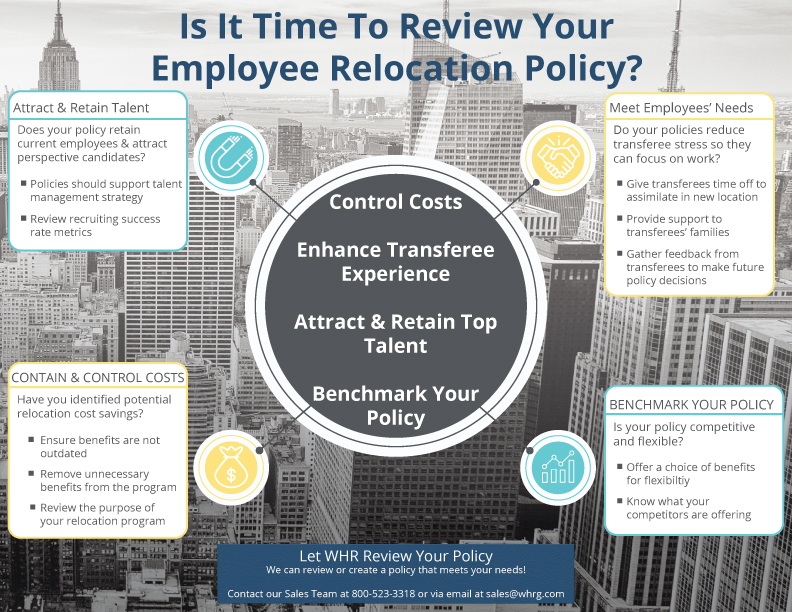Given the many changes businesses have encountered from COVID-19, including employees working remotely, you might think there’s no reason to review your company’s employee relocation policy right now. Well, think again. Many companies are still relocating employees to fill needed roles. Reviewing your policy and making needed adjustments now can help your organization in the following areas:
The following examples are from policy reviews WHR Global conducted for its clients. These examples demonstrate just how important it is to review your relocation policy on a regular basis.
A.控制商业成本和停止支付不必要的福利
Make sure you’re allocating the right amount of dollars to both transferees and organizational needs. It’s also essential that you’re not paying for unnecessary or outdated benefits.
- 例子 1
我们审查的一家公司的政策是给每个调职者一笔标准的5千至1万美元的搬迁费,以帮助支付任何额外的费用。他们还在5K-1万美元的一次性款项之外,给了高管们相当于6周工资的一次性款项。由于一些高管的工资很高,这笔津贴有时相当于每位高管5万美元!在审查后,我们建议该公司减少对高管的补贴。经过审查,我们建议该公司减少对高管的这种做法。该公司节省了几十万美元。 - Example #2
A client was paying a cost of living differential if the employee was relocating to a higher cost area. They were paying this out for 3–4 years, plus they were also providing a big lump sum benefit. We recommended a minimum 5% cost of living threshold so that they were not paying transferees moving to only slightly higher cost of living areas. The client saved millions. - Example #3
Another client was giving out non-promotional bonuses to current employees willing to relocate for a lateral role. These bonuses equated to 5% of the employees’ salaries. Since this practice is not common, we recommended they eliminate this from their relocation policy, which saved them significant costs without lowering the value of their program. - Example #4
One of our clients was paying a loan origination fee. Some lenders don’t even charge this fee, but if they know the client will pay, they will still charge the fee anyway. Once the client realized this, they stopped paying the fee unless necessary.
B.满足你的雇员的需求
It’s important that your relocation policy meets your transferees’ needs. This helps to reduce transferee stress so that employees can focus on work in their new location. Giving transferees time off to assimilate in their new location, providing support to transferees’ families, and gathering post-relocation feedback to make future policy decisions will all help to address your transferees’ needs.
- Example #1
One of our clients was offering a lump sum benefit for all international relocations. By gathering post-relocation survey feedback, we found out transferees were trying to coordinate their own international household goods (HHG) shipments and were not spending the full lump sum, in hopes of keeping some money. The survey feedback also showed that giving employees that level of choice was adding more stress on them, and it was making the relocation process take longer. Basically, transferees were trying to do it all on their own plus pinch pennies. The client considered all key benefits and determined the lump sum was not working. They shifted from a lump sum to a core flex benefit. This meant the client would cover HHG shipments, destination service providers and temporary housing, but they still gave transferees a lump sum amount to be used at the employees’ discretion. Not only did this help reduce transferee stress, but it also helped control business costs.
- Example #2
One client was not offering destination services to the spouses/partners and families of intra-European moves. They assumed that if a transferee/family was relocating from Russia to the UK, for example, destination services were not needed. Through post-relocation survey feedback, it was determined that spouses/partners required career assistance, language training and help with school searches for their children. The employee had office workers to help them assimilate in the new locations, but the transferees’ partners were struggling with the new language and even struggling to find necessities like grocery stores. Recognizing the needs of the entire family unit, and not just the transferee, is crucial to ensuring a successful move and assimilation.
C.吸引/留住人才 加之以竞争为基准的政策
希望你的搬迁政策已经是你的整体奖励和人才管理战略的一部分。正确的政策将帮助你的公司留住现有的员工,并吸引潜在的候选人。一个薄弱的搬迁政策可能会对你的招聘成功率产生负面影响。
Benchmarking your policy against other companies will help you stay competitive in the war for talent. Make sure your policy provides a choice of offerings, since relocation policies are wrapped into job offers. If you don’t benchmark against your competitors, you won’t know if your offerings are good or not. Are they subpar to what everyone else is offering? If you are hiring high level executives, for example, and the talent is very specific and not easy to come by, you’ll want to make sure you’re competitive with salary, benefits, and your relocation policy.
At the same time, benchmarking will ensure you’re not giving away too much when none of your competitors are doing that. Benchmarking your policy against others shows you are in line with the industry. It’s also important to not only look at your industry, but also other industries you compete with for talent.
- Example #1
Imagine losing a potential candidate because your relocation policy is missing benefits your competitors are including. For example, if your candidate is an executive expecting a full buyout, but your policy only includes a HHG move and lump sum payout, then you have to go back and forth negotiating with your superiors and the candidate. This can waste a lot of time. In the interim, the candidate might receive a better job offer, including more relocation benefits. A relocation policy can be a factor for candidates deciding whether to take one job over another. If you’ve benchmarked your policy against your competition, you’ll already know what their policies include.
- 示例 #2
一位客户从其人才招聘团队得到反馈,说很难填补某些职位。在审查了他们的政策并将其与竞争对手进行比较后,我们发现,他们的竞争对手提供的搬迁福利要丰富得多。因此,该公司决定扩大有资格享受全面搬迁福利的职位范围。
D.你应该多久审查一次你的政策?
WHR recommends you review your employee relocation policy annually or every couple of years at the very longest. It does not have to be a huge overhaul, but it’s a chance for you to pause and look at employee feedback. Additionally, you should confirm any changes in your company culture, driving principles, core values, talent strategy, the industry, and your competition. The review is a time for you to make sure your policy is aligned with all of those pieces and your key stakeholders (talent acquisition teams, recruiting teams, HR business partners).



